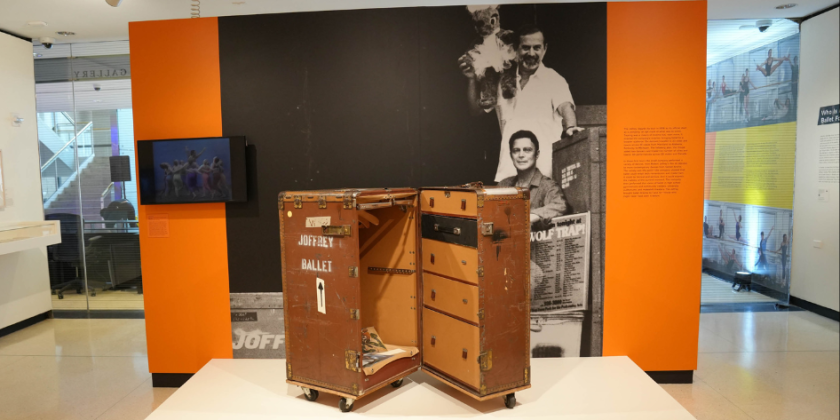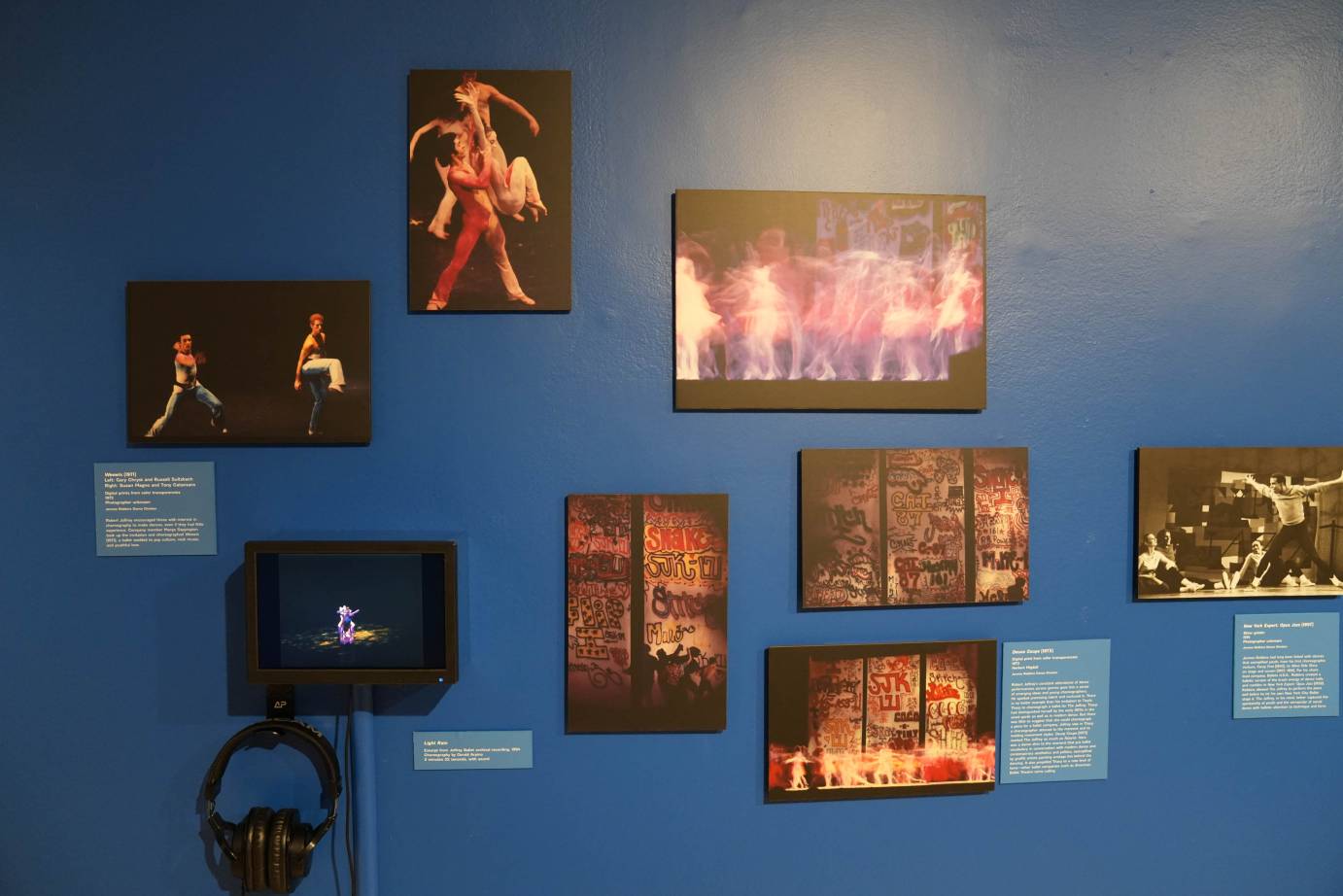DAY IN THE LIFE OF DANCE: "The Joffrey + Ballet in the US" at New York Public Library (Part 1)

WHAT: The Joffrey + Ballet in the U.S.
WHERE: New York Public Library for the Performing Arts
WHEN: Now until March 1, 2025
WHO: Curated by Julia Foulkes, Assistant Curator: Nicole Duffy
A group of young people stride toward the camera in the video that welcomes viewers to The Joffrey + Ballet in the U.S., an ambitious exhibition at the New York Public Library for the Performing Arts, running now through March 1, 2025.
They look like ordinary twenty-somethings, but as we watch the sequence repeat, leotards and rehearsal togs replace overcoats and street clothes. Eager and unpretentious, these youngsters are from the Joffrey Ballet, and the excerpt from a 1965 television program shows them in the halcyon days of the Dance Boom stepping forward to greet new audiences.

Joffrey Ballet poster featuring Trinity, 1978. Photo by Herbert Migdoll © Joffrey Ballet via Jerome Robbins Dance Division
This clever introduction goes straight to the heart of an exhibition dedicated to the Joffrey, once a major New York cultural institution that attracted an international following with its trendy repertoire and showmanship. The Joffrey didn’t wait for audiences to come to it — it came to them. Yet its populism wasn’t enough. Financial woes eventually brought it low, forcing the company to decamp to Chicago in 1995. Since then, some critics have bewailed the death of ballet as an art form; and the Joffrey Ballet’s past troubles seem emblematic of a general decline. Thus, larger questions frame this retrospective of the company’s glory years.
Exhibition curator Julia Foulkes, a historian at The New School, avoids the dreaded word “accessibility” as she weighs classical ballet’s prospects for survival. She wants us to think about who makes up the ballet audience. What kinds of works should ballet companies perform? And who will pay to support these grandly scaled, labor-intensive organizations, beloved by die-hard fans but ignored by the masses? Foulkes also wants to know what ballet should look like in the future. How can classical ballet, with its pointe shoes and proscenium stages endure in a society that is rapidly digitizing and cutting its ties to the past? This final question begs the widest application, and we may ask the same of all our legacy institutions. With techno-fascists seeking to mechanize and control us, what hope is there for any of the arts in a future without human beings?

Dancer and choreographer Robert Joffrey and his partner and fellow choreographer, Gerald Arpino, were lucky. They founded their company in 1956, in a fertile climate of economic and cultural expansion. In that long-ago America, two gay men with a passion for dance could nurture grand ambitions. Exhibition visitors are also lucky, in that the heyday of the Joffrey Ballet dovetailed with the rise of television and video. While that technology would compete with the lively arts, it also allowed the Joffrey to broadcast and preserve its work. We can still see some of the dances and the wonderful artists who performed them. Videos of the company in action are a thrilling feature of the current exhibition, amid the usual fading souvenirs.
Among Robert Joffrey’s early teachers in his native Seattle was the Mariinsky-trained Ivan Novikoff, and the young dance student’s greatest inspiration was the Ballet Russe de Monte Carlo. When Joffrey formed his own ensemble, the fledgling outfit would inherit the Ballet Russe’s identity as a touring company. Yet Joffrey Ballet’s mission was not just to sow the seeds of high-brow culture in American soil, but also, when funded by the U.S. State Department, to project a smiling image of American freedom abroad. Thus, alongside Arpino’s dented steamer trunk, and an exhausting 8-week tour schedule displayed in a glass case, the first room in the NYPL’s exhibition contains a poster from a 1962-63 tour that included Afghanistan, and a video shows the dancers breathing frostily as they emerge from the Hotel Ukraine in Moscow. Visitors may shudder at this foreshadowing of America’s 21st-century battlefields, now that our government has abandoned cultural diplomacy in favor of terrorism and war.

The Joffrey at Wolftrap, Virginia, c. 1970s. Photo by Herbert Migdoll © Joffrey Ballet, via the Jerome Robbins Dance Division
The Joffrey had another mission peculiar to its era: to capture the attention of the Baby Boom generation, that exploding demographic whose idealism and unfettered curiosity about sex, drugs, and Eastern spirituality dominated American culture in the 1960s. A clue to how the company would proceed comes in a video pairing excerpts from Joffrey’s Pas de Déesses (1954) with Arpino’s Incubus (1962). Exuberant, not precious, Joffrey’s Romanticism places a distinctly populist emphasis on virtuosity; while Arpino’s psycho-sexual drama involves an immature child-woman who becomes hysterical when a lover snatches away her rag doll, and kisses her.

Twyla Tharp's Deuce Coupe, 1973. Photo by Herbert Migdoll © Joffrey Ballet via the Jerome Robbins Dance Division

The breakthrough, however, came with Joffrey’s Astarte (1967). In this ballet, dancer Maximiliano Zomosa rose from the audience and stripped off his clothes climbing on stage into an eye-popping multi-media womb. Blending ancient mysteries with psychedelia, Astarte’s erotic couplings set to a commissioned Pop-rock score located the audience’s g-spot. Life magazine fussed asking worriedly, “How far is far enough?”
Though New York Times critic Clive Barnes initially found the ballet “crass” and “commercial,” he had to admit Astarte was a cultural milestone; and the Joffrey Ballet had embodied the spirit of the times. The rock ‘n roll ballet would become a Joffrey trademark, from Trinity(1970), to Deuce Coupe (1973), to Billboards (1993); while, as late as 1981, the company continued to celebrate sexual liberation in Arpino’s orgiastic Light Rain.

In the years following Astarte, the youth-oriented company also aligned itself with the anti-war movement reviving Kurt Jooss’ scathing The Green Table (1967), and premiering Arpino’s The Clowns (1968), a tear-drenched ballet on the theme of nuclear apocalypse. The Joffrey addressed civil rights in Eugene Loring's These Three, and portrayed urban anomie in Anna Sokolow’s Rooms. According to Joffrey Ballet historian Sasha Anawalt, British critics disdained the company’s populism and its anti-war message, and British impresarios sought to stifle it.
Elsewhere, however, the troupe created a sensation. In her book The Joffrey Ballet: Robert Joffrey and the Making of an American Dance Company, Anawalt writes, “The crush at the door for the Joffrey Ballet tickets at the Vienna Festival was so overwhelming that the city’s strict fire laws were broken, and people were herded in without seats for them to sit in.” A scene like that is unimaginable today.
Could ballet companies in 2024 still profit from the Joffrey Ballet’s example? Alas, the times have changed. With the onset of AIDS, the sexual revolution of the 1960s lost its innocence; and in our post-truth society, political ideals are less clear-cut. How are artists supposed to function in today’s climate of fear, censorship, and looming authoritarianism?











